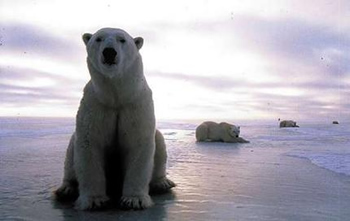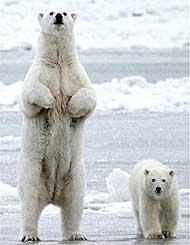Untitled Document

Polar bears - the world's largest bears - are facing a bleak future
because of global warming and experts want them declared a vulnerable species.
(Photo: The Age)
Wildlife researchers have found new evidence that Arctic polar bears,
already gravely threatened by the melting of their habitat because of global
warming, are being poisoned by chemical compounds commonly used in Europe and
North America to reduce the flammability of household furnishings like sofas,
clothing and carpets.
A team of scientists from Canada, Alaska, Denmark and Norway is sounding the alarm
about the flame retardants, known as polybrominated diphenyls, or PBDEs, saying
that significant deposits have recently been found in the fatty tissues of polar
bears, especially in eastern Greenland and Norway's Svalbard islands.
Studies are still being carried out on what impact the chemicals might be having
on the bears, but tests on laboratory animals such as mice indicate that their
effects can be considerable, attacking the sex and thyroid glands, motor skills
and brain function.
There is also evidence that compounds similar to the PBDEs have contributed
to a surprisingly high rate of hermaphroditism in polar bears. About one in
50 female bears on Svalbard has both male and female sex organs, a phenomenon
scientists link directly to the effects of pollution.
 |
|
Toxic waste creates hermaphrodite Arctic polar bears
|
"The Arctic is now a chemical sink," declared Colin Butfield, a campaign
leader for the Worldwide Fund for Nature, which last month indicated that killer
whales in the Arctic were also suffering from elevated levels of contamination
with fire retardants as well as other man-made compounds. "Chemicals from
products that we use in our homes every day are contaminating Arctic wildlife."
The pollutants are carried northwards from industrialised regions of the US
and western Europe on currents and particularly on northbound winds. Contaminated
moisture often condenses on arriving in the cold Arctic climes and is then deposited,
ready to enter the food chain.
For several years, scientists have observed how the concentrations of the pollutants
are magnified as they ascend the food chain, from plankton to fish and then
to marine mammals such as seals, whales and polar bears. The new study, first
published last month in the journal Environmental Science and Technology, shows,
for instance, that one compound was 71 times more concentrated in polar bears
than in the seals they normally feed upon.
Conservationists are especially alarmed by these new findings because of the
already fragile condition of the Arctic polar bear populations, some of which
could be devastated before the end of the century. As warming temperatures erode
their hunting grounds, polar bears in Canada's western Hudson Bay region, for
instance, saw their numbers slide from 1,100 in 1995 to only 950 in 2004.
The dangers now posed by the PBDEs are reminiscent of the crisis 30 years ago
over PCBs - polychlorinated biphenyls - a highly toxic by-product of many industries
that was also found to be migrating to the Arctic. The dumping of PCBs was swiftly
banned. Since 2004, manufacturing has stopped in the US of two of the most toxic
retardants, called penta and octa. Stockpiles of both still exist, however.
According to Derek Muir, of Canada's Environmental Department and a leader
of the new research, there are signs of a slightly different retardant, typically
used in construction materials and furnishings, also showing up in the Arctic
and in the bears, called HBCD. "It's a chemical that needs to be watched,
because it does biomagnify in the aquatic food webs and appears to be a widespread
pollutant."
The research team tested 139 bears captured in 10 different locations across
the Arctic region. They found that the bears in Norway's Svalbard, a wildlife
refuge where all hunting is banned, had 10 times the levels of the chemicals
than bears in Alaska and four times those in Canada.

